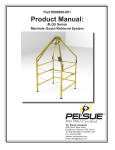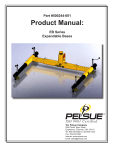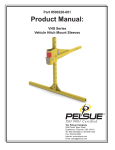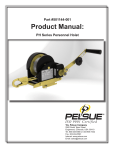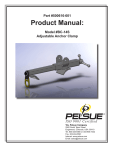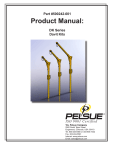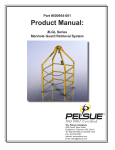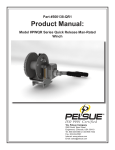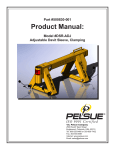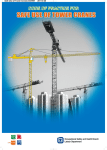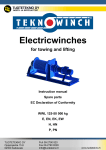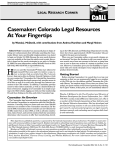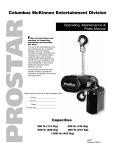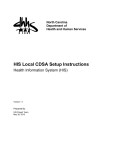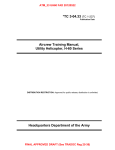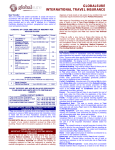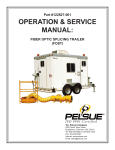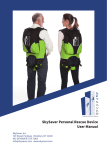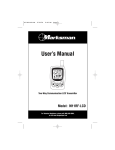Download Product Manual:
Transcript
Part #500930-007 Product Manual: Model #RT07 Rescue & Retrieval Tripod IS O 9 0 0 1 Ce r tifie d T.A. Pelsue Company 2500 South Tejon Street Englewood, Colorado, USA 80110 Tel. 800-525-8460 or 303-936-7432 Fax. 303-934-5581 Internet: www.pelsue.com Email: [email protected] Page 2 #500930-007 - Product Manual - Model #RT07 Rescue & Retrieval Tripod - Revision 01 - Date: 06-01-2009 IS O 9 0 0 1 Ce r tifie d S ince our inception in 1963 – the T.A. Pelsue Company has designed and manufactured high quality equipment to improve the personnel efficiency and working conditions in various underground, confined, and outdoor areas. Founded by T. Allen Pelsue, the company has established a continuing reputation for excellence in the production of fine products for a broad spectrum of industry throughout the world. Now, in our second generation of family direction, continued commitment to innovation and quality makes Pelsue a leading source of equipment for many types of confined spaces. We specialize in safety, retrieval, fall arrest, ventilation, cable placing, splicing, and maintenance nationally and abroad. With more than 70,000 square feet of facilities available, Pelsue continues the dedication that has made us pre-eminent in this field. #500930-007 - Product Manual - Model #RT07 Rescue & Retrieval Tripod - Revision 01 - Date: 06-01-2009 Page 3 Contents Section Description Page # 1.0......................................General Information..................................5 1.1...........................Quality Policy 1.2...........................Warranty 2.0......................................Introduction & Product Information........7 2.1...........................Serial Number 3.0......................................Configuration & Assembly........................ 8 4.0......................................Safety.......................................................... 9 4.1...........................Warning Statements 4.2...........................Safety Alert Symbol 4.3...........................General Safety Information 4.4...........................Operating Safety 4.5...........................Maintenance Safety 4.6...........................New Operator Safety Information 5.0......................................Product Operation....................................12 5.1...........................Product Description & Capabilities 5.2...........................Product Installation & Set-Up 6.0......................................Compliance & Capacity............................18 7.0......................................Maintenance & Inspection........................19 7.1..........................Maintenance 7.2..........................Inspection 7.3..........................Inspection Log 8.0......................................Storage.......................................................22 9.0.................................... Contact Information..................................22 Page 4 #500930-007 - Product Manual - Model #RT07 Rescue & Retrieval Tripod - Revision 01 - Date: 06-01-2009 1.0 General Information 1.1 Quality Policy T.A. Pelsue Company Quality Policy OUR GOAL IS THE PURSUIT OF NEVER-ENDING IMPROVEMENT IN PRODUCT QUALITY AND BUSINESS SYSTEMS. Methods to be employed in attaining this goal will include new product quality planning, employee training, and utilization of employee involvement groups to solve problems. In an increasingly competitive marketplace, ensuring customer satisfaction is one of the differentiators that sets you apart from the pack and yields a competitive advantage. Therefore, we will support total customer satisfaction by implementing the ISO 9001 Quality System and providing the necessary atmosphere and training to nurture this concept throughout our organization. We will make every business decision as though the quality of the part or service provided was destined for our own or our family’s use. We will always think Quality First. Every T.A. Pelsue Company employee is expected to commit to this philosophy in the performance of his or her daily tasks. QUALITY FIRST! T.A. PELSUE COMPANY SENIOR MANAGEMENT TEAM #500930-007 - Product Manual - Model #RT07 Rescue & Retrieval Tripod - Revision 01 - Date: 06-01-2009 Page 5 1.2 - Pelsue Product Warranty Pelsue products are designed and engineered to perform as stated in published specifications. Quality materials and workmanship are used in the manufacture of this product. With regular maintenance and proper care, Pelsue equipment provides many trouble free hours of operation. The T.A. Pelsue Company warrants to the buyer that the Hoist Product furnished will conform to specifications and will be free from defects in material and workmanship from the date of shipment to the original buyer, for a period of 3 months (90 days). In the event of failure of any components of a Pelsue product within the warranty period, service must be pre-approved by the T.A. Pelsue Company, and service must be performed by the T.A. Pelsue Parts and Service Department in Englewood, Colorado, or at the option of the T.A. Pelsue Company, service may be performed at any designated service center, which may include any authorized service center for the component manufacturer. Unauthorized repairs will not be covered by this warranty. Damage or failure due to misuse, mishandling, or unauthorized modifications will not be covered by this warranty. Unless otherwise agreed, the T.A. Pelsue Company shall repair or replace the defective components within (30) calendar days of notice of failure. T.A. Pelsue Company’s obligation hereunder, shall be limited to the repair or replacement of the product or component as set forth above and shall not include any liability whatsoever for damages caused by such failure, including, but not limited to consequential or incidental damages flowing from use or lack of use of product. Any replacement, repair, modification, installation, or other service performed by the T.A. Pelsue Company shall be warranted by the remainder of the unexpired period of the warranty, or for a period of (90) calendar days, whichever is longer. All materials or parts returned for credit or warranty shall be returned only with prior approval, and will be subject to factory inspection before credit is allowed, Parts claimed defective will be replaced upon request and will be invoiced as purchased, subject to credit when the parts claimed to be defective have been received and examined by the factory. This warranty is expressly in lieu of all other warranties expressed or implied, including any warranties of merchantability or warranties of fitness for any particular use and all other obligations or liabilities in connection with the sale of this equipment. T.A. Pelsue Company, 2500 South Tejon Street, Englewood, Colorado 80110, 800-525-8460 Page 6 #500930-007 - Product Manual - Model #RT07 Rescue & Retrieval Tripod - Revision 01 - Date: 06-01-2009 2.0 - Introduction & Product Information Congratulations on your choice of a Pelsue RT07 Rescue & Retrieval Tripod to compliment your confined space entry/retrieval operation. This equipment has been designed and manufactured to exceed confined space requirements and regulations to meet the needs of the discriminating operator for the efficient and safe entry or retrieval of personnel from a confined space. Safe, efficient and trouble-free operation and maintenance for your component or system requires that you or anyone else who will be operating, maintaining, or inspecting the equipment, read, understand and follow all the safety, installation, operation, maintenance and inspection instructions contained in this manual. This manual covers the retrieval products manufactured by Pelsue. Use the Table of Contents or Index as a guide to find specific information. Keep this manual handy for reference and for assistance in the training of new operators. Establish a regular training program for experienced and new operators per these instructions. Establish a regular maintenance and inspection program to keep the equipment in top condition. This product is a part of a confined space entry/retrieval system for personnel. The user must read, understand and follow the instructions contained in this manual for each component or total system before using this equipment. Establish an appropriate training, maintenance and inspection program for your people and the equipment. Failure to follow these instructions could result in serious injury or death. 2.1 - Serial Number Product Serial Number Always give your dealer the serial number of your Pelsue confined space entry/retrieval product when ordering parts or requesting service or other information. The Serial Number decal is permanently embossed with a serial number. The Serial Number decal will appear as shown below in Figure 2a and is located on the sheave equipped leg (see Figure 2b). A space has been provided below for recording of the serial number for future reference. MODEL: SERIAL NUMBER LOCATION RT07 Serial Number: Date of Manufacture (DOM): Figure 2a: Serial Number Decal #500930-007 - Product Manual - Model #RT07 Rescue & Retrieval Tripod - Revision 01 - Date: 06-01-2009 Figure 2b: Serial Number Decal Location Page 7 3.0 - Configuration & Assembly Upon initial receipt of the RT07 system, inspect the packaging for any evidence that the product may have been damaged in shipment. While unpacking the product, inspect all of the components for damage. If damage to any of the components is discovered, DO NOT USE THE PRODUCT! Alert the shipping carrier immediately of the damage to the shipment. Replacement Parts Identification Table 2 (Refer to Figure 3.0) Item Part Number Number Description 1 500216-003 Foot with Pad, Rescue Tripod 2 500412-350 Pin & Lanyard, Cable Retention 3 500411-002 Pin & Lanyard, Leg Positioning 4 121458-001 O-RIng, Pin Lanyard Retention 5 500238-001 Decal - “Attention - This Structure...” 6 44N-011100 Chain, Restraint, 21’ length (Not Shown) 7 121536-002 Quick Link, Chain (Not Shown) 5 4 3 Figure 3.0: RT07 Parts Diagram 1 Figure 3.0b: RT07 Folded Orientation Verify that all parts are present before product use. The #RT07 is shipped fully assembled. 1. Ensure that the product has been shipped with all the necessary components and is in working order 7) #500238-001 Page 8 **Refer to parts list above for common replacement parts. If replacement parts are required, they can be ordered from the T.A. Pelsue Company at 800-525-8460. #500930-007 - Product Manual - Model #RT07 Rescue & Retrieval Tripod - Revision 01 - Date: 06-01-2009 4.0 - Safety SIGNAL WORDS: Note the use of the signal words DANGER, WARNING and CAUTION with the safety messages. The appropriate signal word for each message has been selected using the following guidelines: DANGER- Indicates an imminently hazardous situation that, if not avoided, will result in death or serious injury. This signal word is to be limited to the most extreme situations or for hidden or unseen hazards. WARNING- Indicates a potentially hazardous situation that, if not avoided, could result in death or serious injury and includes obvious and hidden hazards. It may also be used to alert against unsafe practices. CAUTION- Indicates a potentially hazardous situation that, if not avoided, may result in minor or moderate injury. It may also be used to alert against unsafe practices. You are responsible for the safe operation, maintenance and inspection of your Pelsue RT07 Rescue Tripod. You must ensure that anyone who will operate, maintain, inspect or work around the equipment be familiar with the operating and maintenance procedures and related safety information contained in this manual. This manual will take you step-by-step through the workings and capabilities of the #RT07 Tripod and alerts you to good safety and operating practices while using the system. Remember, you are the key to safety. Good safety practices not only protect you but also the people around you. Make these practices a working part of your safety program. Be certain that everyone operating this equipment is familiar with the procedures recommended and follows safety precautions. Remember, most accidents can be prevented. Do not risk injury or death by ignoring good safety practices. • System owners must give operating instructions to operators or employees before allowing them to use the equipment and at least annually thereafter. • The most important safety device on this equipment is a safe operator. It is the operator’s responsibility to read and understand all safety and operating instructions in the manual and to follow these. Most accidents can be avoided. • A person must understand the operation of this equipment and be trained in it’s usage before operating the equipment. An untrained operator exposes himself and others to possible serious injury or death. • Do not modify the equipment in any way. Unauthorized modification may impair the function and/or safety and could affect the life of the equipment. • Think SAFETY! Work SAFELY! 4.1 - Warning Statement WARNING! Products manufactured or sold by T.A. Pelsue Company are intended for use by professionals trained and experienced in the use, inspection and maintenance of these products. Paraprofessional users such as volunteer rescue workers and sportsmen involved in risk sports such as climbing and caving will be held to the same standard of experience and training as professionals. Technical rescue, rappelling, climbing and the training involved are hazardous activities. Each situation has its own unique conditions and must be evaluated. Effective risk management comes from experience, proper training and good personal judgement. #500930-007 - Product Manual - Model #RT07 Rescue & Retrieval Tripod - Revision 01 - Date: 06-01-2009 7!2.).' Failure to read and heed all labels and instructions may result in injury or death. Inspect all components before and after each use, and remove from service if any damage or defect is found. Keep product free from dirt and moisture. Do not leave a suspended load unattended. Do not exceed maximum rated loads. Page 9 4.2 - Safety Alert Symbol SAFETY ALERT SYMBOL This Safety Alert symbol means ATTENTION! BECOME ALERT! YOUR SAFETY IS INVOLVED! The Safety Alert symbol identifies important safety messages on your Pelsue Retrieval Product and in the manual. When you see this symbol, be alert to the possibility of personal injury or death. Follow the instruction in the safety message. Why is this symbol important to you? 3 BIG Reasons: Accidents Disable and Kill. Accidents Cost You Money. Accidents Can Be Avoided. 4.3 - General Safety Info 1. Read, understand and follow the User Manual and all safety signs before using, maintaining or inspecting the equipment. 2. Refer to and follow applicable standards and regulations. Comply with requirements of local regulations for your applications. 3. Establish an equipment-use training program for inexperienced employees. Only trained, competent persons shall use the equipment. An untrained operator is not qualified to operate the system. 4. Have a first-aid kit available for use should the need arise and know how to use it. 5. Provide a fire extinguisher for use in case of an accident. Store in a highly visible place. 6. Install and properly secure all guards and shields before operating. 7. Wear appropriate protective gear. This list includes but is not limited to: • A hard hat • Protective shoes with slip resistant soles • Heavy gloves • Protective clothing • Face Protection 8. Review and follow the Pre-Operation Checklist before using a component in the system or system itself. 9. Establish a regular maintenance and inspection program with your equipment and maintain detailed records. 10. Review safety related items and operating instructions with all personnel on a regular basis. 4.4 - Operating Safety 1. Read, understand and follow the User Manual and signs on the product before using, maintaining or inspecting the equipment. 2. Train all operators before allowing them to use the product. An untrained operator exposes themselves, bystanders and workers to possible serious injury or death. 3. Visually inspect the product and all auxiliary components and equipment before using. Correct any problems before using the equipment. 4. Securely anchor the product before using. 5. Use only certified anchor and connector components in your system. 6. Use only an approved full body harness for the workers. Page 10 #500930-007 - Product Manual - Model #RT07 Rescue & Retrieval Tripod - Revision 01 - Date: 06-01-2009 4.4 - Operating Safety (Continued) 7. Always work in teams. One person acts as the entrant to the confined space and the other acts as the attendant outside of the space, always prepared to initiate a non-entry-rescue if required,. Pelsue recommends an additional attendant/rescuer for stand-by in case of an emergency. 8. Do not exceed the capacity of the anchor points or pulley system at any time (see section 7.0). 9. Establish a regular training program for new and experienced workers. 10. Establish a detailed inspection program for your equipment and document the findings. Return the equipment to the manufacturer for service if any defects are found. 11. Plan your work program before starting. Have the required people, equipment and procedures available to do the job. 12. Do not use the equipment around physical or environmental hazards. This list includes but is not limited to: • Corrosion that may affect the structural integrity of the lifeline or other components. • Chemicals which can degrade components in a manner which can not be visually identified. • Toxic gases: Rescuers or workers can be killed in toxic environments. • Heat or elevated temperatures. • Moving machinery: Workers or auxiliary equipment can be contacted by or pulled into moving components. •Sharp edges: Workers or the rescue equipment can be injured by or damaged by sharp edges or components. • Electrical hazards: Stay away from power lines or components carrying electrical power. • Overload: Do not overload the tripod at any time during operation (see section 7.0). • Follow confined space regulations and standards. 4.5 - Maintenance Safety 1. Read, understand and follow the User Manual and signs on the product before using, maintaining or inspecting the equipment. 2. ANSI and OSHA require a regular inspection program for all confined space entry/retrieval equipment and to maintain documented results of these inspections. Follow the inspection procedure contained in this manual and use the inspection form to document the results (see section 8.0). 3.Keep instructional and safety signs clean and legible at all times. Clean or replace as required. 4. Remove the equipment from service if a problem is found during the inspection. Return to an authorized repair depot or the factory for service. 4.6 - New Operator or Owner The Pelsue RT07 Rescue & Retrieval Tripod is designed to assist a person/entrant to enter a confined space and assist in exiting if required. Every new operator must read, understand and follow the instructions in the manual. No one should be allowed to use the equipment without training. The training should be reviewed with experienced operators on a regular basis. At regular intervals, perform a detailed inspection of the equipment and document the results. Remove from service if deficiencies are found. Alterations or misuse of this equipment or failure to follow instructions may result in serious injury or death. It is the responsibility of the owner’s organization or operator to read this manual and to train all other operators before they start working with the equipment. Follow all safety instructions exactly. Safety is everyone’s business. By following recommended procedures, a safe working environment is provided for the operator, bystanders and the area around the worksite. Untrained operators are not qualified to operate the equipment. Many features incorporated into this equipment are the result of suggestions made by customers like you. Read this manual carefully to learn how to operate the equipment safely and how to set it to perform as intended. By following the operating instructions in conjunction with a good maintenance program, your product will provide many years of trouble free service. #500930-007 - Product Manual - Model #RT07 Rescue & Retrieval Tripod - Revision 01 - Date: 06-01-2009 Page 11 5.0 - Product Operation The following section will address the capabilities and the general operation of the RT07 Rescue and Retrieval Tripod. The instructions contained within this section should be adhered to each and every time the product is used. Any person tasked with installing or operating the piece of equipment should be familiar with these procedures. 5.1 - Product Description & Capabilities The RT07 Rescue & Retrieval Tripod is built from aircraft grade aluminum, and is specifically designed for rescue and industrial applications. Telescoping anodized-aluminum legs allow for height adjustments in 5” increments per leg. The unique legs also adjust to any angle to meet the most demanding situations. Cast-aluminum head contains three heavy duty rigging plates/anchor points on three sides, plus a man rated, cable ready, pulley sheave built into it. All specifications, instructions, and procedures provided within this manual or upon Pelsue Specification Documents are based upon and only valid for usage with Pelsue approved accessories. The T.A. Pelsue Company can not verify equipment safety and/or compliance when utilized with anything other than Pelsue products. Rescue Tripod - #RT07 General Specifications • Minimum Height (@ top of head) - 4’ – 7-1/2” • Maximum Height (@ top of head) - 7’ – 2-1/2” • Radius of Tripod Feet (@ Max Height) - 7’ – 10-1/2” • Folded Orientation - Length - 5’ – 3” - Width - 9-3/4” • Weight - 44 LB. (20 kg) Load Capacity 350 LB. • Single user with maximum weight of 350 lbs. [159 KG] MAXIMUM • Refer to loading diagrams for proof loads (Figure #5.1b) CAPACITY Features: • No load supporting welds • Three separate rigging plates/anchor points • Feet convert to soft ground anchors and are pre-drilled for anchor bolts or stakes • Legs adjust in 5” increments per leg • Can be used as an A-frame • Base chain included to prevent legs from spreading Materials & Construction • Leg Tubes - Anodized or Powder Coated Figure #5.1a 6061-T6 Aluminum #RT07 • Feet - Cast Aluminum • Head - Cast Aluminum • Anchor Points - Formed Carbon Steel • Sheave - UHMW Polyethylene ! CAUTION ! - The user must ensure that the ground area or base structure utilized for operation is capable of withstanding the weight of the system combined with the system proof loads in order to retain the stated compliance of the entire system. ! CAUTION ! - The user must ensure that the ground area utilized for operation is relatively level and debris-free in order to retain the stated compliance and stability of the entire system. ! CAUTION ! - The user must ensure that the leg pins are locked in place when the legs are deployed in order to retain the stated compliance of the entire system. Page 12 #500930-007 - Product Manual - Model #RT07 Rescue & Retrieval Tripod - Revision 01 - Date: 06-01-2009 5.1 - Product Description & Capabilities (Continued) TEST LOAD APPLIED AS SHOWN SHEAVE LINE IS REEVED OVER THE PULLEY AND AFFIXED TO LEG-MOUNTED WINCH BRACKET 3100 LB. [1406 KG] SHEAVE PROOF LOAD 8093 LB. [3671 KG] VERTICAL ANCHOR POINT PROOF LOAD Figure #5.1b #RT07 Loading Diagram @ Maximum Height Additional Requirements & Notes • Tripod Feet must be secured together with provided chain & snap link when used in tripod configuration. • Winch Bracket must be attached to leg securely with provided pins for operation with winch. • Legs must be equally adjusted in height and pinned prior to loading. System Requirements The Pelsue RT07 Rescue & Retrieval Tripod is a component in a confined space entry/retrieval system. The product and all auxiliary components must be compatible to prevent creating unexpected hazards. A list of system compatibility requirements includes but is not limited to: 1. Anchorage The RT07 Rescue & Retrieval Tripod is designed to stand alone and function as a portable anchor device. When using another system or anchorage method, anchorage points must meet ANSI and OSHA standards or local regulations. Qualified people are required to approve non-standard anchorage systems before they are used. 2. Connectors Use only approved connectors with sufficient capacity that have an anti-rollout device designed into the snap. Nonapproved connectors can open during use and create unexpected hazards. Do not use them. Pelsue recommends using a twist-lock or tri-lock carabiner for connection devices. 3. Personnel Harness Use only an approved full body harness. Do not use a single belt or strap system. Only a full body harness can provide the required support for the body to prevent injury. #500930-007 - Product Manual - Model #RT07 Rescue & Retrieval Tripod - Revision 01 - Date: 06-01-2009 Page 13 5.1 - Product Description & Capabilities (Continued) Applications 1. General The Pelsue Tripod is designed to be used in work support or rescue applications. 2. Scope The product works best in vertical applications. However, different mounting, anchoring and support systems are required for other applications. The user has the responsibility of reading and following the instructions for the other systems in addition to the product. Misuse or abuse of any component can create hazards for personnel. 3. Emergency Rescue In emergency situations, use the product to remove personnel from a hazardous or an unsafe environment. In these situations, a back-up fall arrest system is generally not required. Be sure to use the proper mounting and anchoring system for the product. Use only an approved harness for personnel. Always be aware of the system limitations and follow the instructions. 4. Limitations Operators must be aware of several limitations on the use of the product whenever it is used and plan their work accordingly. Limitations include but are not limited to: a. Corrosion Do not keep the product in an area that has a corrosive atmosphere. Corrosive vapors can be released by sewage plants or in fertilizer plants. Sea water or spray can also cause corrosion to the case, lifeline or other components. Long term exposure to these types of environments will require more frequent inspections to ensure that the function of the unit has not been affected. b. Chemical or Toxic Environments Work environments that contain strong acids, bases or other corrosive chemicals in solutions, sprays or vapors may damage the product or auxiliary components. Inspect the unit frequently to detect any damage or change in functionality of the unit. Chemical damage may be difficult to detect visually and periodic lifeline replacement is recommended to insure safety. c. Electrical Hazards Stay away from power lines or other components carrying electrical power. The metal lifeline can conduct electricity if it gets close to or contacts a power line or electrified component. Remember, electricity can jump across an air gap and electrocute personnel using the product. Contact your local utility to remove or disconnect the power before working around these components. Contact Pelsue for synthetic rope options to reduce conductivity. d. Load Capacity Do not exceed the product capacity of the RT07 Tripod in any configuration (includes people, harness, tools, etc.). Overloading the product can exceed the design safety factors and could create hazards. e. Training Do not allow anyone to use this product unless they are trained in its limitations and use. Untrained operators can expose themselves and others to hazards. Train new operators before using the unit. Review operating procedures on a regular basis with experienced personnel. Page 14 #500930-007 - Product Manual - Model #RT07 Rescue & Retrieval Tripod - Revision 01 - Date: 06-01-2009 5.2 - Product Installation & Set-Up Prior to Operation, the RT07 Rescue Tripod should be configured and prepared according to the following guidelines. 1. Pre-Operation Inspection: It is necessary to perform a visual inspection prior to each time using the product. If deficiencies are found, remove the product from service and contact the T.A. Pelsue Co. regarding repair. The following checklist coupled with Figure #5.2a should be used as a guide to determine whether the equipment is in good operating condition prior to usage. Equipment that is not in good condition can endanger the safety of the entrant and attendant during use. The Pre-Operation Visual Inspection is not limited to, but must include the following items; a. Check that the product has no structural defects, such as dents, bends, cracks, or fractures. b. Ensure that all product rating & warning labels are clear and legible. c. Functional check: - Make sure legs adjust properly - Make sure built-in pulley is free of defects & spins freely d. Check that the feet pivot freely. e. Check that all hardware (Pins, Levelling Screws, Bolts) have not been damaged and is in working condition. PULLEY ANCHOR BRACKET UPPER LEG LOWER LEG FEET Figure #5.2a: RT07 Pre-Operation Inspection Points #500930-007 - Product Manual - Model #RT07 Rescue & Retrieval Tripod - Revision 01 - Date: 06-01-2009 Page 15 5.2 - Product Installation & Set-Up (Continued) 2. Setup of #RT07 Rescue & Retrieval Tripod: Choose a location where installation will provide suitable proximity to the work area yet minimize obstructions during use and in the event a rescue is necessary. Once a location is chosen; a. With the tripod in its folded position, lay the tripod down on its side. To extend the legs of the tripod, the safety lock pins must first be pulled out. (Figure #5.2b) Then extend each leg to the desired length for the appropriate height. Ensure that all three legs are at equal lengths. Re-insert the safety lock pins into each leg. (Figure #5.2c) b. Attach any connections, haul systems, or carabiners to the anchor points (located on the head assembly (Figure 5.2d). Ensure all equipment connected to the head assembly are in their locked positions. After hauling equipment is connected and is in working order, the tripod can now be lifted to its upright position. c. Once the tripod is in an upright position, spread each leg out to the largest possible base width. (Figure #5.2e) Then move each leg approximately 2” inwards to ensure there is no outward pressure on the head of the tripod. (On expanded metal decks, you may use “T” or “J” bolts to further secure the base of the tripod) d. Install the chain around the entire base of the tripod in order to prevent the legs from spreading under extreme loads. To do this, you must open the oval link which connects the two ends of the chain. Pass one end of the chain through the openings in each of the three feet and reconnect the end of the chain to the oval link (remove any slack in the chain at this time). (Figure #5.2f) e. For storage, remove all equipment connected to the head assembly. Remove the chain around the base of the tripod and fold each leg in one at a time. Lay the tripod on its side then remove the safety lock pins and insert the lower legs back into the upper legs and reinsert the safety lock pins when lower legs are inserted as much as possible. SAFETY LOCK PINS Figure #5.2b Folded Figure #5.2c Folded - Legs Extended CHAIN THROUGH OPENING Figure #5.2f Foot Figure #5.2d Head Assembly Page 16 Figure #5.2e Legs Spread #500930-007 - Product Manual - Model #RT07 Rescue & Retrieval Tripod - Revision 01 - Date: 06-01-2009 5.2 - Product Installation & Set-Up (Continued) 2. Setup of cable using built-in pulley: a. If using a Pelsue Man-Rated Winch, attach the winch to the tripod leg with the built-in pulley. A winch bracket can be purchased from Pelsue Model #MB-TL1. Figure #5.2g shows the winch bracket on the leg of the tripod. b. Once the winch is attached to the leg, pay out the cable or rope, remove the cable retention pin located over the head sheave and pass the snap hook through the center hole of the head and down through the center of the tripod.(Figure #5.2i) c. Ensure that the cable or rope lays within the groove of the sheave and re-insert the cable retention pin to keep the cable or rope from coming off of the sheave. (Figure #5.2j) Figure #5.2g RT07 with #MB-TL1 Winch Bracket Figure #5.2h RT07 with Pelsue Model #PW10C SECURITY PIN ENSURE LINE LAYS IN GROOVE OF SHEAVE AND SECURITY PIN KEEPS LINE IN PLACE Figure #5.2i Head Assembly Figure #5.2j Head Assembly #500930-007 - Product Manual - Model #RT07 Rescue & Retrieval Tripod - Revision 01 - Date: 06-01-2009 Page 17 6.0 - Compliance & Capacity Compliance: • Fall Arrest When utilizing the fixed anchor points on the head assembly, The Pelsue Model #RT07 Rescue Tripod is compliant as a fall arrest anchorage for; 1. A Single Person as per ANSI Z359.1 OR, 2. Two People as per ANSI A10.14 & OSHA 1926 When utilizing the tripod as a Portable Anchor System, The Pelsue Model #RT07 Rescue Tripod is compliant as a portable anchorage for; 1. A Light-Use Portable Anchor Device as per NFPA 5.5.4.1 & 5.5.4.2 2. A General-Use Portable Anchor Device as per NFPA 5.5.4.3 & 5.5.4.4 When utilizing the tripod’s built-in pulley system in conjunction with an SRL (Self-Retracting Lifeline) device, the Pelsue Model #RT07 Rescue Tripod is compliant as a fall arrest anchorage for; 1. A Single Person as per ANSI A10.14 & OSHA 1926 All above stated compliance contingent upon the following conditions a. Users are connected utilizing an approved 900 LB. MAF (maximum arrest force) device. b. The system is installed and utilized by a qualified individual, as defined by applicable ANSI & OSHA Standards. c. Tripod is properly erected following the procedure in this manual, including the adjustment and installation of the included leg restraining chain. • Man-Rated Rescue, Retrieval, and Positioning When utilizing the tripod’s built-in pulley system in conjunction with a personnel winch device, the Pelsue Model #RT07 Rescue tripod is rated as a personnel lifting & lowering structure for; 1. A Single Person of 310 LBS. (141 Kg.) maximum weight (inclusive of all tools and equipment) with a 10:1 Factor of Safety OR, 2. A Single Person of 350 LBS. (159 Kg.) maximum weight (inclusive of all tools and equipment) with better than an 8:1 Factor of Safety When utilizing the fixed anchor points on the head assembly as an attachment point for rigging and hauling devices it is the user’s responsibility to infer the rating of the tripod based upon the proof loads reported in this section, the capabilities of the rigging/hauling device, and the required Factor of Safety for the task at hand. Page 18 #500930-007 - Product Manual - Model #RT07 Rescue & Retrieval Tripod - Revision 01 - Date: 06-01-2009 7.0 - Maintenance & Inspection MAINTENANCE & INSPECTION 1. 2. Read, understand and follow the User Manual and signs 3.Keep instructional and safety signs clean and legible at on the product before using, maintaining or inspecting all times. Clean or replace as required. the equipment. 4. Lubricate product as per instructions in Section 6. ANSI and OSHA require a regular inspection program 5. Remove the equipment from service if a problem is found for all confined space entry/retrieval equipment and to during the inspection. Return to an authorized repair maintain documented results of these inspections. Follow depot or the factory for service. the inspection procedure contained in this manual and use the inspection form to document the results. 7.1 - Maintenance 7.1 MAINTENANCE INTERVALS Before Each Use: 1. Visual Inspection Perform a complete visual inspection. Refer to section 7.2. Remove from service if a defect is found. Annually: 1. Clean Product: Use a damp cloth and mild soap to clean the frame and labels of dirt and residue. Be sure that the labels are legible. 2. Complete Inspection: Perform a complete inspection. Refer to section 7.2. Record results and keep documentation. 3. Factory Service Inspection: It is recommended that the product be serviced by a factory authorized service center or the manufacturer after a period of three years. Extreme working conditions may indicate the necessity to increase the frequency. Annual servicing shall include but not be limited to an intensive inspection and cleaning of all internal and external components. Failure to provide proper service may shorten product life and could endanger performance or function. 7.2 - Inspection A complete visual inspection should be performed on the product prior to using. The following items should be checked: 1. Labels: Check that all of the labels are clean and legible. Clean the labels if any are dirty using mild soap and a damp cloth. Replace if any are illegible. 2. Fasteners: Check that all screws and other fasteners are tight. Tighten if any are loose. Replace if any are missing. 3. Frame: Check the frame and housing for cracks, dents, bends or breaks. If there are major dents or any other structural damage, the unit should be removed from service and returned to the factory for inspection. **A thorough inspection inclusive of the items listed above should be performed at least annually (more frequently when the product is used consistently) by a qualified person, the results should be recorded in a log like the one provided in Section 7.3. #500930-007 - Product Manual - Model #RT07 Rescue & Retrieval Tripod - Revision 01 - Date: 06-01-2009 Page 19 7.3 - Inspection Log Model Number : Serial Number : Date Purchased : Place a check (¥) in the box if item is acceptable, place an x (X) in the box if item requires maintenance or repair Date Tripod Head Upper Legs Lower Legs Pulley System Pins & Fasteners Notes Inspector (print & sign) : Inspector (print & sign) : Inspector (print & sign) : Inspector (print & sign) : Inspector (print & sign) : Inspector (print & sign) : Inspector (print & sign) : Inspector (print & sign) : Page 20 #500930-007 - Product Manual - Model #RT07 Rescue & Retrieval Tripod - Revision 01 - Date: 06-01-2009 7.3 - Inspection Log (Continued) Date Tripod Head Upper Legs Lower Legs Pulley System Pins & Fasteners Notes Inspector (print & sign) : Inspector (print & sign) : Inspector (print & sign) : Inspector (print & sign) : Inspector (print & sign) : Inspector (print & sign) : Inspector (print & sign) : Inspector (print & sign) : Inspector (print & sign) : Inspector (print & sign) : #500930-007 - Product Manual - Model #RT07 Rescue & Retrieval Tripod - Revision 01 - Date: 06-01-2009 Page 21 8.0 - Storage Prior to storage, the product should be thoroughly inspected and maintained. Repair or replace any worn or damaged components to prevent any unnecessary down time at the next use. Follow this procedure: 1. Thoroughly clean the entire unit using a mild soap on the frame and labels. 2. Perform a complete inspection of the unit and document the results. 3. To dismantle & store the Tripod, first remove the chain from the base of the Tripod. 4. Carefully lower the Tripod to the ground, and inspect each leg before adjusting to it’s storage size. 5. Remove all haul system connections / components at this time. 6. R elease the safety pins and shorten the legs to the minimum length. Replace the safety pins and place the Tripod into it’s carry case. Store in a cool, dry place. 9.0 - Contact Information For More Information... T.A. Pelsue Company 2500 S. Tejon St. Englewood, CO 80110 Toll Free: Telephone: Fax: 1-800-525-8460 1-303-936-7432 1-303-934-5581 Website: www.pelsue.com Email: [email protected] Page 22 #500930-007 - Product Manual - Model #RT07 Rescue & Retrieval Tripod - Revision 01 - Date: 06-01-2009 NOTES: #500930-007 - Product Manual - Model #RT07 Rescue & Retrieval Tripod - Revision 01 - Date: 06-01-2009 Page 23 I SO 9001 C e rt i f i e d T.A. Pelsue Company 2500 South Tejon Street, Englewood, Colorado, USA 80110 Toll free 800-525-8460 or 303-936-7432 Fax. 303-934-5581 Internet: www.pelsue.com Email: [email protected]
























